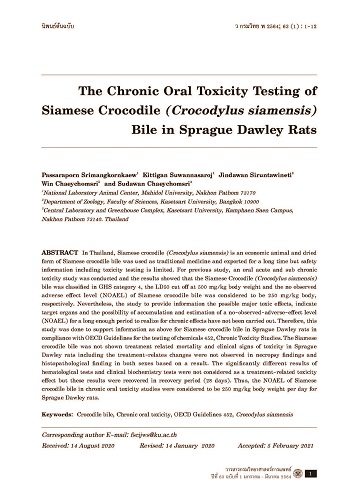การทดสอบความเป็นพิษเรื้อรังทางปากของน้ำดีจระเข้สายพันธุ์ไทย (Crocodylus siamensis) ในหนูแรทสายพันธุ์ Sprague Dawley
คำสำคัญ:
น้ำดีจระเข้, การทดสอบความเป็นพิษเรื้อรัง, OECD Guidelines หมายเลข 452บทคัดย่อ
จระเข้สายพันธุ์ไทยเป็นสัตว์เศรษฐกิจที่สำคัญของประเทศ น้ำดีจระเข้สายพันธุ์ไทยถูกนำมาใช้เป็นยาแผนโบราณ และส่งขายต่างประเทศมาเป็นเวลานาน แต่ข้อมูลความปลอดภัยมีอยู่อย่างจำกัด การ ศึกษานี้มีจุดประสงค์เพื่อให้ข้อมูลเกี่ยวกับความเป็นพิษ อวัยวะเป้าหมาย การสะสม และประเมินระดับความปลอดภัยของการใช้น้ำดีจระเข้สายพันธุ์ไทยในหนูแรทสายพันธุ์ Sprague Dawley ตามวิธีการมาตรฐาน OECD Guideline หมายเลข 452 ในการทดสอบความเป็นพิษเรื้อรังทางปากจะทำการป้อนสารให้สัตว์ทดลองในระดับ 2.5, 25 และ 250 มิลลิกรัม/กิโลกรัมน้ำหนักตัว ต่อเนื่องกันเป็นเวลา 365 วัน ผลการทดสอบพบว่า น้ำดีจระเข้สายพันธุ์ไทย ไม่ก่อให้เกิดความเป็นพิษในสัตว์ทดลอง สัตว์ทดลองทุกตัวมีสุขภาพปกติ น้ำหนักตัว ปริมาณการบริโภคน้ำ และอาหารปกติตลอดระยะเวลาการทดสอบ ไม่พบการเปลี่ยนแปลงทางพยาธิวิทยาที่มีความแตกต่างกันระหว่างกลุ่มควบคุมและกลุ่มทดสอบที่ระดับ 250 มิลลิกรัม/กิโลกรัมน้ำหนักตัวในสัตว์ทดลองทั้ง 2 เพศ สำหรับผลการวิเคราะห์เลือดทางโลหิตวิทยา และเคมีคลินิก พบว่า ตัวแปรที่มีความแตกต่างกันอย่างมีนัยสำคัญทางสถิติ สามารถกลับสู่ภาวะปกติได้ภายในระยะเวลา 28 วันหลังหยุดให้สารทดสอบ จากผลการศึกษาทั้งหมดสรุปได้ว่า น้ำดีจระเข้สายพันธุ์ไทยไม่มีความเป็นพิษต่อสัตว์ทดลองที่ระดับ 250 มิลลิกรัม/กิโลกรัมน้ำหนักตัว เมื่อได้รับต่อเนื่องเป็นระยะเวลา 365 วัน
เอกสารอ้างอิง
Praduptong A, Siruntawineti J, Chaeychomsri S, Srimangkornkaew P, Chaeychomsri W. Acute oral toxicity testing of siamese crocodile (Crocodylus siamensis) oil in wistar rats. Biosci Discov 2018; 9(3): 409-15.
Srimangkornkaew P, Praduptong A, Siruntawineti J, Chaeychomsri S, Chaeychomsri W. The evaluation of acute oral toxicity testing of siamese crocodile (Crocodylus siamensis) bile in Sprague Dawley rats in compliance with OECD guideline 423. Biosci Discov 2018; 9(4): 469-73.
Picheinsutthorn C, Jeerawong, V. Animal medicinal materials. In: Hand out of Thai medicinal pharmacy. 3rd ed. Bangkok, Thailand: Amarin Press; 2003. p. 150-167.
Pharmacopoeia Commission of PRC, editors. Pharmacopoeia of the People's republic of China. Beijing, China: Chemical Industry Press; 1997.
Maddison JE, Page SW, Church DB, editors. Small animal clinical pharmacology. In: Alexander JG, Jill EM, Grant G, editors. Gastrointestinal drugs. 2nd ed. London, United Kingdom: Saunders Ltd.; 2008. p. 469-497.
Chiang JY. Bile acid metabolism and signaling. Compr Physiol 2013; 3(3): 1191-212.
The Metabolomics Innovation Centre (TMIC). Showing metabocard for Coprocholic acid (HMDB0000601). [online]. 2005; [cited 2018 Nov 26]; [12 screens]. Available from: URL: https://hmdb.ca/metabolites/HMDB0000601.
Song W, Li SS, Qiu PP, Shen DY, Tian L, Zhang QY, et al. Apoptosis induced by aqueous extracts of crocodile bile in human heptacarcinoma SMMC-7721. Appl Biochem Biotechnol 2013; 170(1): 15-24.
Kang JH, Zhang WQ, Song W, Shen DY, Li SS, Tian L, et al. Apoptosis mechanism of human cholangiocarcinoma cells induced by bile extract from crocodile. Appl Biochem Biotechnol 2012; 166(4): 942-51.
Organisation for Economic Co-operation and Development (OECD). OECD guidelines for the testing of chemicals, test No. 423: acute oral toxicity – acute toxic class method. [online]. 2001; [cited 2019 Oct 20]; [14 screens]. Available from: URL: https://ntp.niehs.nih.gov/iccvam/suppdocs/feddocs/oecd/oecd_gl423.pdf.
Srimangkornkaew P, Praduptong A, Siruntawineti J, Chaeychomsri S, Chaeychomsri W. Acute oral toxicity of Crocodylus siamensis bile in sprague dawley rats. Bull Dept Med Sci 2020; 62(1): 16-25.
Organisation for Economic Co-operation and Development (OECD). OECD guidelines for the testing of chemicals, test No. 408: repeated dose 90-day oral toxicity study in rodents. [online]. 1998; [cited 2019 Oct 20]; [10 screens]. Available from: URL: https://www.oecd.org/env/ehs/testing/E408_1998.PDF.
Srimangkornkaew P, Praduptong A, Siruntawineti J, Chaeychomsri S, Chaeychomsri W. Sub-chronic oral toxicity of Crocodylus siamensis bile in sprague dawley rats. Bull Dept Med Sci 2020; 62(2): 50-8.
Organisation for Economic Co-operation and Development (OECD). OECD guidelines for the testing of chemicals, test No. 452: chronic toxicity studies. [online]. 2009; [cited 2019 Oct 20]; [16 screens]. Available from: URL: https://www.oecd.org/env/ehs/testing/E452_2009.pdf.
Chaeychomsri W, Siruntawineti J, Osotsila I. Process suitable for the preservation of crocodile gall bladder for adding value to product. In: Proceeding of the 35th congress on science and technology of Thailand.; 2009 Oct 15–17; Chonburi, Thailand. Bangkok, Thailand: The Science Society of Thailand Under the Patronage of His Majesty the King; 2009. p. 569-576.
Chaeychomsri W, Siruntawineti J. Process for preparation of crocodile blood powder and its product, Thai Petty Patent No. 5074. Bangkok, Thailand: Kasetsart University; 2006.
National Research Council. Guide for the care and use of laboratory animals. 8th ed. Washington, DC: The National Academies Press; 2011.
Institutional Animal Care and Use Committee. Guidelines for euthanasia of rodent fetuses and neonates. [online]. 2013; [cited 2019 Jun 18]; [3 screens]. Available from: URL: https://oacu.oir.nih.gov/sites/default/files/uploads/arac-guidelines/b4_rodent_euthanasia_pup.pdf.
Mooi E, Sarstedt M. Hypothesis testing & ANOVA. In: A concise guide to market research. 3th Edition. Berlin, Heidelberg: Springer; 2011. p. 113-160.
Tanaka H, Suzuki S, Ninomiya F, Matsubara K, Hakoi K. Spontaneous thymoma in a 10-week-old sprague-dawley rat. J Toxicol Pathol 2012; 25(1): 37-40.
Torres V, Grantham J, editors. Cystic diseases of the kidney. In: Brenner B, editor. The Kidney. 6th ed. Philadelphia, United States: Saunders Elsevier 2008; p. 1451-1453.
National Kidney and Urologic Diseases Information Clearinghouse (NKUDIC). Simple kidney cysts. [online] 2012; [Cited 2019 (Jun 18]; [4 screens]. Available from: URL: https://www.niddk.nih.gov/-/media/Files/Kidney-Disease/Simple_Kidney_Cysts_508.pdf.
National Toxicity Program. Urinary bladder-proteinaceous plug. [online]. 2016; [cited 2019 Oct 18]; [2 screens] Available from: URL: https://ntp.niehs.nih.gov/nnl/urinary/urinary_bladder/protplug/.
Navarro VJ, Lucena MI. Hepatotoxicity induced by herbal and dietary supplements. Semin Liver Dis 2014; 34(2): 172-93.
Bailey RL, Gahche JJ, Lentino CV, Dwyer JT, Engel JS, Thomas PR. Dietary supplement use in the United States, 2003-2006. J Nutr 2011; 141(2): 261-6.
Navarro VJ, Khan I, Björnsson E, Seeff LB, Serrano J, Hoofnagle JH. Liver injury from herbal and dietary supplements. Hepatology 2017; 65(1): 363-73.




